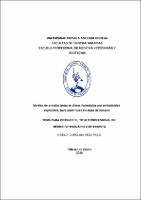Mostrar el registro sencillo del ítem
Niveles de proteína bruta en dietas formuladas por aminoácidos digestibles, para codornices en etapa de postura
| dc.contributor.advisor | Castillo Soto, Wilson Lino | |
| dc.contributor.author | Vega Polo, Greicy Carolina | |
| dc.creator | Vega Polo, Greicy Carolina | |
| dc.date.accessioned | 2020-10-26T23:11:18Z | |
| dc.date.available | 2020-10-26T23:11:18Z | |
| dc.date.issued | 2020 | |
| dc.identifier.uri | https://hdl.handle.net/20.500.12759/6686 | |
| dc.description.abstract | Con el objetivo de evaluar el efecto del nivel de proteína bruta de las dietas formuladas por aminoácidos digestibles en las dietas de codornices en la fase de postura, se utilizaron 200 codornices de 35 a 97 días de edad, alojadas en jaulas de diez aves cada una distribuidas a través de un diseño completo al azar (DCA) con cuatro tratamientos (15, 17, 19 y 21% de PB) y cinco repeticiones. Las dietas fueron formuladas para alcanzar el nivel de PB según el tratamiento y suplementadas con aminoácidos (Lisina, Metionina, Treonina, Triptófano, Valina) para alcanzar los niveles de aminoácidos digestibles requeridos, en todos los tratamientos por igual. Las variables evaluadas fueron producción de huevos, peso del huevo, masa de huevo, consumo de alimento, conversión alimenticia, beneficio económico y concentración de nitrógeno en excreta. Los resultados fueron analizados a través del análisis de varianza de regresión. Los niveles de proteína bruta en la dieta no influyeron significativamente (p>0.05) sobre la producción de huevos, consumo de alimento, masa de huevo y conversión alimenticia. El peso del huevo presentó un comportamiento lineal de aumento a la medida que aumentó la PB en la dieta y consecuentemente también los aminoácidos Arginina, Isoleucina, Leucina e Histidina. El beneficio económico mejoró y la excreción de nitrógeno se redujo con los niveles inferiores de proteína bruta en la dieta. Concluyéndose que es factible el uso de dietas con menores niveles de PB, desde que se atienda el requerimiento de aminoácidos digestibles. | es_PE |
| dc.description.abstract | In order to evaluate the effect of the crude protein level of the diets formulated by digestible amino acids in the quail diets in the laying phase, 200 quail from 35 to 97 days of age, housed in cages of ten birds each, were used. distributed through a randomized complete design (DCA) with four treatments (15, 17, 19 and 21% PB) and five repetitions. The diets were formulated to reach the PB level according to the treatment and supplemented with amino acids (Lysine, Methionine, Threonine, Tryptophan, Valine) to reach the levels of digestible amino acids required, in all treatments equally. The variables evaluated were egg production, egg weight, egg mass, feed consumption, feed conversion, economic benefit and nitrogen concentration in excreta. The results were analyzed through the analysis of variance of regression.The levels of crude protein in the diet did not significantly influence (p> 0.05) on egg production, feed intake, egg mass and feed conversion. The weight of the egg presented a linear increase behavior to the measure that increased the PB in the diet and consequently also the amino acids Arginine, Isoleucine, Leucine and Histidine. The economic benefit improved and the nitrogen excretion was reduced with the lower levels of crude protein in the diet. Concluding that it is feasible to use diets with lower CP levels, since the requirement for digestible amino acids is met | en_US |
| dc.description.abstract | In order to evaluate the effect of the crude protein level of the diets formulated by digestible amino acids in the quail diets in the laying phase, 200 quail from 35 to 97 days of age, housed in cages of ten birds each, were used. distributed through a randomized complete design (DCA) with four treatments (15, 17, 19 and 21% PB) and five repetitions. The diets were formulated to reach the PB level according to the treatment and supplemented with amino acids (Lysine, Methionine, Threonine, Tryptophan, Valine) to reach the levels of digestible amino acids required, in all treatments equally. The variables evaluated were egg production, egg weight, egg mass, feed consumption, feed conversion, economic benefit and nitrogen concentration in excreta. The results were analyzed through the analysis of variance of regression.The levels of crude protein in the diet did not significantly influence (p> 0.05) on egg production, feed intake, egg mass and feed conversion. The weight of the egg presented a linear increase behavior to the measure that increased the PB in the diet and consequently also the amino acids Arginine, Isoleucine, Leucine and Histidine. The economic benefit improved and the nitrogen excretion was reduced with the lower levels of crude protein in the diet. Concluding that it is feasible to use diets with lower CP levels, since the requirement for digestible amino acids is met | en_US |
| dc.description.uri | Tesis | es_PE |
| dc.format | application/pdf | es_PE |
| dc.language.iso | spa | es_PE |
| dc.publisher | Universidad Privada Antenor Orrego - UPAO | es_PE |
| dc.relation.ispartofseries | T_MED.VETE_146 | |
| dc.rights | info:eu-repo/semantics/openAccess | es_PE |
| dc.source | Universidad Privada Antenor Orrego | es_PE |
| dc.source | Repositorio Institucional - UPAO | es_PE |
| dc.subject | Proteína | es_PE |
| dc.subject | Digestibles | es_PE |
| dc.title | Niveles de proteína bruta en dietas formuladas por aminoácidos digestibles, para codornices en etapa de postura | es_PE |
| dc.type | info:eu-repo/semantics/bachelorThesis | es_PE |
| thesis.degree.level | Título Profesional | es_PE |
| thesis.degree.grantor | Universidad Privada Antenor Orrego. Facultad de Ciencias Agrarias | es_PE |
| thesis.degree.name | Médico Veterinario Zootecnista | es_PE |
| thesis.degree.discipline | Medicina Veterinaria y Zootecnia | es_PE |
Ficheros en el ítem
Este ítem aparece en la(s) siguiente(s) colección(es)
-
Veterinaria y Zootecnia [163]

